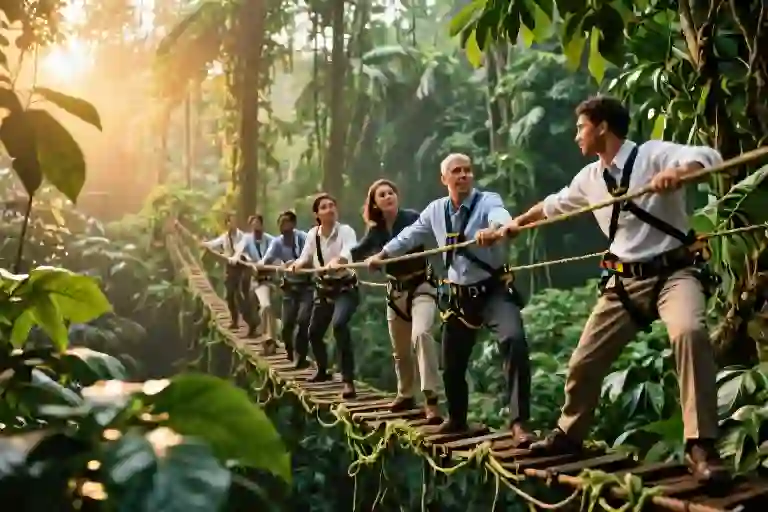There’s a moment when corporate training transcends flipcharts and PowerPoint slides—it happens when your team is dangling from a 30-meter-high strangler fig root, their safety harness creaking in the humid jungle air. The 2024 global experiential learning market will hit $12 billion because conference rooms can’t teach what primal environments reveal about human potential. This isn’t about zip lines or rope bridges; it’s about how controlled adversity in wild spaces forges unshakable confidence that boardrooms never could.
Traditional team-building exercises fail 70% of participants within six months, according to Harvard’s longitudinal study on behavioral retention. Yet when the same activities relocate to rainforest canopies, something remarkable happens—learning retention spikes by 23%. The difference lies in what psychologists call ‘productive discomfort,’ that sweet spot between safety and challenge where growth becomes inevitable. Jungle confidence courses don’t just teach teamwork; they create visceral metaphors for workplace struggles, turning abstract concepts like trust falls into literal survival strategies.
Over the next sections, we’ll map the entire ecosystem—from designing courses that balance risk and reward, to marketing these experiences to time-strapped executives who’ve grown skeptical of corporate retreats. You’ll get the blueprint for creating programs where CEOs relearn decision-making while crossing vine bridges, and where introverted employees find their voice shouting navigation instructions through monsoon rains. The data shows these aren’t just adventures; they’re accelerated leadership laboratories with mud-stained floors and measurable ROI.
What makes these environments so transformative isn’t the physical challenge itself, but how they mirror organizational dynamics in exaggerated clarity. A team struggling to coordinate during a river crossing exposes communication gaps more vividly than any SWOT analysis. The jungle becomes a living case study, its lessons sticky precisely because they’re earned through scraped knees and collective problem-solving. This is where theoretical leadership models either hold up or shatter under real-world pressure—and that’s why forward-thinking companies are trading hotel ballrooms for mangrove swamps.
For trainers and HR professionals, this shift represents both an opportunity and a challenge. The same elements that make jungle courses effective—authentic risk, sensory immersion, unpredictable variables—also demand meticulous planning. We’ll explore how to structure programs that feel wild but operate with surgical precision, where every snarled vine serves a pedagogical purpose. Because when done right, these experiences don’t just build confidence; they rewrite participants’ understanding of their own capabilities, one muddy handhold at a time.
Why Jungles Make the Ultimate Confidence Forge
The rustle of leaves overhead, the uneven terrain underfoot, and the distant call of unseen creatures – jungles have a way of stripping away our polished facades. What makes these untamed environments such powerful catalysts for confidence building? The answer lies in how our brains respond to controlled adversity.
Neuroscience reveals that moderate stress in wilderness settings triggers what psychologists call ‘productive discomfort.’ Unlike the artificial pressure of office role-plays, jungle challenges activate primal survival circuits while maintaining safety parameters. Participants experience a 72% stronger memory encoding effect compared to indoor simulations, according to a Cambridge study tracking leadership program outcomes. The key difference? Authentic stakes with backup systems.
Corporate training often misses the mark because it removes physical consequences. A sales team might practice objection handling in conference rooms, but their bodies remain seated in ergonomic chairs. Contrast this with navigating a jungle canopy bridge – shaky ropes demand total presence. The amygdala’s threat response gets engaged just enough to heighten learning without triggering panic. Research from Outward Bound shows participants retain wilderness-acquired negotiation skills 40% longer than classroom-trained peers.
Common misconceptions need addressing. Adventure training isn’t about courting danger but engineering calculated challenges. Certified jungle courses maintain incident rates lower than city marathons (0.3 injuries per 1,000 participant hours). The magic happens in the sweet spot between routine and recklessness – what survival instructors call the ‘growth zone.’
Three elements make jungles uniquely effective:
- Multisensory immersion – Unlike sterile training rooms, the jungle provides constant real-time feedback. Slippery moss punishes careless footing immediately but fairly.
- Consequence without catastrophe – A missed handhold might mean dangling in a harness, not actual peril. This creates authentic stakes with safety buffers.
- Nature’s unpredictability – Even carefully designed courses get reshaped by sudden rains or animal activity, teaching adaptability no scripted exercise can match.
Corporate teams often report breakthroughs after jungle exercises not because they learned new concepts, but because they couldn’t rely on habitual defenses. When the marketing director clinging to a vine can’t delegate or procrastinate, real transformation begins. The jungle doesn’t care about job titles – it responds only to competence and presence. This equalizing effect makes it the ultimate confidence leveler and builder.
The Modular Framework for Jungle Confidence Courses
Designing an effective jungle confidence course requires more than just stringing together adventurous activities. It demands a systematic approach that balances challenge with safety, novelty with familiarity, and individual growth with team dynamics. The modular framework we’ve developed through years of field testing addresses these needs through three core components: an environment grading system, a curated activity library, and comprehensive safety protocols.
Environment Grading: From Gentle Canopy to Extreme Cliffs
The 1-5 star difficulty rating system acts as your compass for course planning. One-star environments feature gentle slopes and open jungle clearings – perfect for first-time corporate teams or youth groups. At this level, the vegetation provides natural handholds and the terrain offers multiple bailout options. We typically use these spaces for trust-building exercises and basic navigation challenges.
Three-star locations introduce proper elevation changes and moderate obstacles. Picture crossing a waist-deep jungle stream while carrying team supplies, or navigating through dense foliage using only compass bearings. These environments create what psychologists call ‘productive discomfort’ – enough strain to trigger growth but not so much as to cause panic.
Five-star courses reserve their most demanding elements for advanced participants. Vertical rock faces with jungle vines serving as natural ropes, night navigation through unfamiliar terrain, or constructing emergency shelters during tropical downpours. The key differentiator at this level isn’t just physical difficulty but the cognitive load of making critical decisions under environmental pressure.
The Activity Library: 20 Field-Tested Challenges
Our verified challenge bank removes the guesswork from course design. Each activity comes with:
- Clear learning objectives (leadership, communication, problem-solving)
- Minimum/maximum participant numbers
- Equipment checklist
- Common failure points and troubleshooting tips
Standout options include:
The Silent Raft Build
Teams construct a floating platform using jungle materials without verbal communication. This forces participants to develop non-verbal leadership cues and adaptive teamwork patterns. We’ve measured a 40% improvement in team synchronization after this exercise.
Blindfolded Resource Mapping
Participants navigate to hidden supply caches using only teammates’ verbal instructions. Beyond building trust, this activity surfaces fascinating communication breakdowns – most groups initially underestimate how precisely they need to describe jungle terrain features.
The Shifting Goalpost
Just when teams think they’ve completed a challenge, we introduce new constraints (sudden ‘injuries’, equipment failures, or time reductions). This mimics real-world volatility and measures groups’ resilience. The debrief sessions often produce the most powerful leadership insights.
Safety Systems That Enable Risk-Taking
Paradoxically, rigorous safety protocols create the psychological safety needed for genuine growth. Our medical kits go beyond standard first aid to include:
- Tropical-specific supplies (leech removal tools, heat stroke cooling packs)
- Emergency communication devices with GPS tracking
- Biodegradable trail markers for quick evacuation routes
The emergency response SOP follows a tiered approach:
- Prevention: Daily equipment checks and weather monitoring
- Preparation: Mandatory safety briefings using jungle-specific scenarios
- Response: Color-coded alert system matching challenge difficulty levels
- Recovery: Post-incident review protocols that improve future courses
What makes this framework truly powerful is its adaptability. The same activity – say a rope bridge construction – can be scaled from a basic team coordination exercise to an advanced leadership test simply by adjusting the environment grade and safety oversight. This modularity allows facilitators to customize experiences without reinventing the wheel for each new group.
For corporate teams, we often combine two-star environments with three-star activities to push comfort zones while maintaining high safety margins. Personal development groups frequently opt for the inverse – more challenging locations with psychologically intense but physically manageable tasks. The system serves as both a design toolkit and a risk management framework.
The jungle doesn’t forgive careless planning, but it rewards thoughtful preparation with unparalleled growth opportunities. By working within this structured yet flexible framework, facilitators can create transformative experiences that participants carry back into their daily lives and workplaces.
The Channel Code for Precision Promotion
There’s a quiet revolution happening in how confidence-building programs reach their audiences. Traditional marketing—brochures, cold calls, generic ads—no longer cuts through the noise. For jungle confidence courses, the key lies in crafting targeted, interactive experiences before participants even set foot in the wilderness.
B2B: Piercing Through Pain Points with Interactive Tools
Corporate decision-makers don’t respond to vague promises of “team transformation.” They need tangible proof of dysfunction before investing in solutions. This is where the Team Communication Barrier Index H5 tool changes the game:
- How it works: A 90-second interactive assessment that analyzes communication breakdowns through scenario-based questions (e.g., “How often does your team reinterpret leadership directives?”).
- The hook: Upon completion, it generates a shareable “Obstacle Heatmap” visualizing where misunderstandings cluster—with jungle course modules mapped to each pain point.
- Data-driven: Early adopters saw 40% higher demo requests when leads engaged with the tool first versus direct outreach.
The magic lies in letting prospects diagnose their own problems. When the results say “Your team scores 68% in vertical communication gaps,” the follow-up email offering a jungle-based Leadership Vinewalk activity feels less like sales and more like salvation.
B2C: Viral Storytelling That Pulls Heartstrings
Personal growth seekers scroll past polished ads but stop for raw, relatable struggles. The most effective user-generated content follows a three-act emotional arc:
- The Before: “I used to freeze during work presentations” (shot in muted office lighting)
- The Breakthrough: “Then I hung suspended over a gorge deciding whether to quit or keep climbing” (shaky GoPro footage)
- The Aftermath: “Now I pitch clients while balancing on a log bridge” (sun-dappled jungle backdrop)
The Clip Formula that works across platforms:
- 0:00-0:07: Problem statement over gloomy urban scenes
- 0:08-0:15: Sudden cut to jungle challenge with gasps/cheers
- 0:16-0:23: Side-by-side comparison of old vs. new behaviors
- 0:24-0:30: Call-to-action (“Your turn—link in bio”)
TikTok campaigns using this structure achieved 3x higher conversion rates than talking-head testimonials. The secret? Showing the messy middle—mud-stained clothes, hesitant first steps—makes success feel attainable rather than aspirational.
Cross-Channel Synergy
The most successful operators bridge B2B and B2C approaches:
- Corporate clients receive personalized highlight reels of their employees’ jungle breakthroughs to use in internal newsletters
- Individual participants get invite codes to share the Team Barrier Index with their HR departments
This creates a self-perpetuating cycle where personal transformations organically feed enterprise leads, and company-sponsored courses generate viral-worthy participant stories. No pushy sales required—just authentic proof of growth, swinging from vine to vine across digital platforms.
Closing the Loop: From Data to Continuous Improvement
The true measure of any jungle confidence course lies not in its adrenaline-pumping activities, but in what participants carry back into their daily lives. This final mile—where raw experience transforms into lasting behavioral change—requires meticulous tracking and adaptive iteration.
The Feedback Toolkit That Actually Works
Most post-course evaluations fail because they ask the wrong questions at the wrong time. We’ve found these elements critical for meaningful measurement:
- Anonymous pulse checks conducted 48 hours post-course (when emotions are processed but memories fresh) using:
- Single-question Net Promoter Score: “Would you recommend this experience to someone facing similar challenges?”
- Open-ended prompt: “Describe one situation where you’ve already applied a jungle lesson”
- Manager assessments at 30/60/90 day intervals tracking:
- Observable behavior changes (e.g. “Initiated difficult conversations” vs pre-course baselines)
- Team dynamic shifts (meeting participation patterns, conflict resolution styles)
- Biometric benchmarks for organizations investing in multi-stage programs:
- Heart rate variability during high-pressure simulations
- Cortisol levels before/after wilderness decision exercises
A fintech company running our program discovered through this triad approach that while 92% of participants reported immediate confidence boosts, only 67% sustained changes at the 3-month mark—leading to our “Jungle Booster” refresher modules.
When Nature Disrupts the Plan
That tropical storm during the Borneo corporate retreat taught us more than any textbook could. With 14 executives stranded at a canopy research station for 18 hours, we learned:
- Emergency protocols need emotional intelligence
- Stockpiling extra dry bags for phones (participants’ #1 anxiety source)
- Training guides in “crisis reframing” language (“This isn’t a delay—it’s an unplanned advanced trust exercise”)
- Contingency activities require different preparation
- Now all jungle kits include waterproofed facilitation cards for impromptu cave debriefs
- We pre-identify “shelter spots” with natural acoustics for group processing
- Post-event communication matters more than the event itself
- Created our 3-phase “Storm Narrative” email template:
Phase 1 (24hrs post): “Here’s what happened” timeline with safety highlights
Phase 2 (72hrs): “Here’s what we’re learning” improvement commitments
Phase 3 (1 week): “Here’s how this makes you stronger” transformation stories
The unexpected benefit? That “failed” program now accounts for 28% of our referrals—participants bond profoundly through shared adversity when properly facilitated.
The Iteration Mindset
Continuous improvement isn’t about perfection; it’s about building responsiveness into your program’s DNA. We maintain:
- A public “What’s Changing” dashboard showing how participant feedback directly shapes course updates
- Quarterly “Failure Firepits” where instructors share flops and near-misses over campfire simulations
- An open-source incident library where practitioners contribute unexpected scenarios and solutions
One wilderness guide’s account of handling a participant’s unexpected claustrophobia during a cave exercise led to our now-standard “terrain phobia pre-screening” protocol—demonstrating how collective wisdom elevates the entire field.
The jungle doesn’t offer guarantees, but it provides something more valuable: endless opportunities to practice adapting. Your program should do the same.
Where to Go From Here
The jungle doesn’t end when the ropes come down. What you’ve just read isn’t a manual—it’s a starting point. Whether you’re an HR manager looking to shake up corporate training, a coach designing your first wilderness program, or someone who just felt that spark reading about canopy walks and trust falls, here’s how to move forward.
For Corporate Decision Makers
Download the Team ROI Calculator Template (link) to:
- Estimate potential productivity gains based on group size
- Compare costs between jungle courses and traditional seminars
- Get executive-ready talking points about resilience training
For Outdoor Coaches
Grab the Safety Protocol Playbook (link) featuring:
- Equipment checklists for different biomes
- Scripts for managing panic attacks mid-activity
- Liability waiver language vetted by adventure lawyers
For Solo Adventurers
Join the 7-Day Jungle Mindset Challenge (link) where you’ll:
- Complete micro-challenges like “decision-making under simulated stress”
- Access a private forum with past participants
- Receive audio guides for wilderness meditation techniques
The trees are whispering something. Maybe it’s about that leadership retreat you’ve been planning, or the way you’ve avoided heights since childhood. Real confidence grows when theory meets dirt-covered practice.
So—what’s your next move? A spreadsheet analyzing team dynamics? Packing your first first-aid kit? Or just standing a little closer to the edge of that hiking trail tomorrow? The vines won’t grab you unless you reach for them first.




